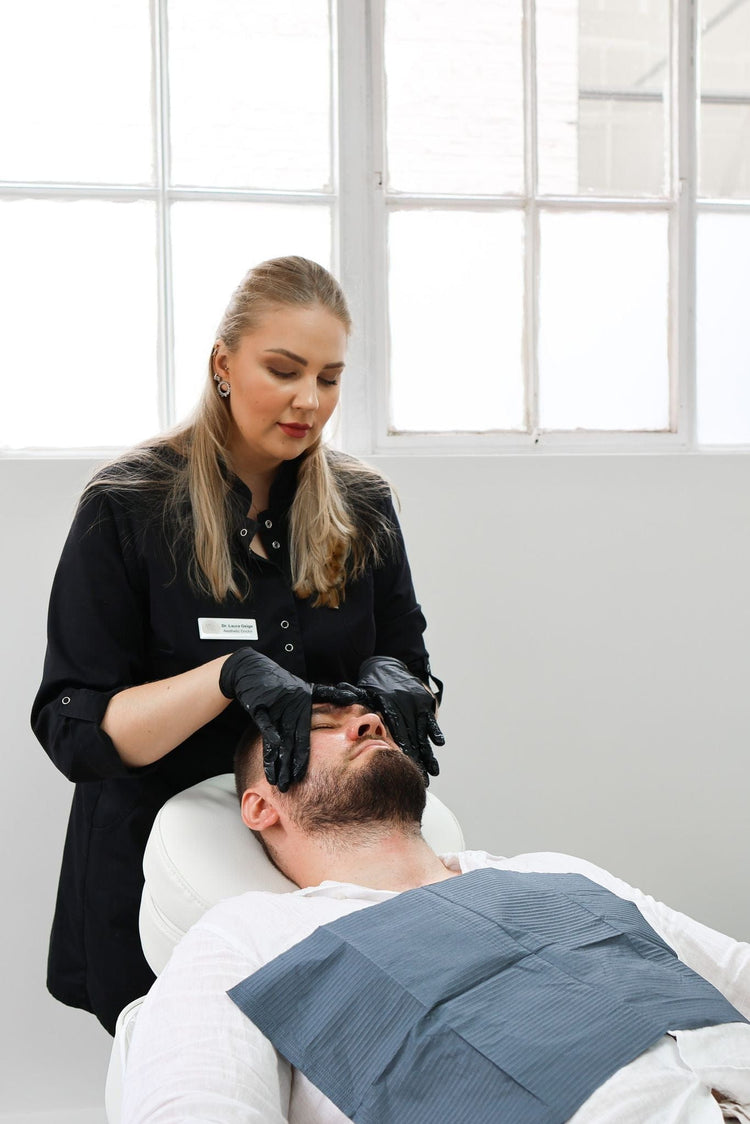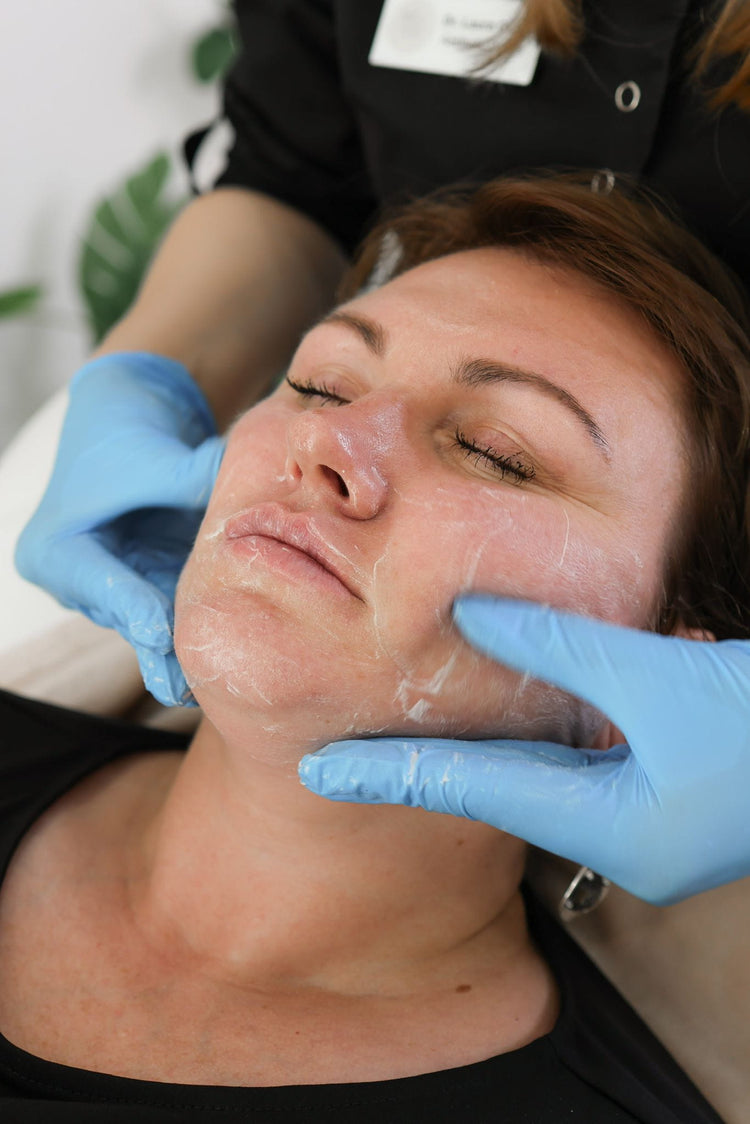Assessment and Diagnosis
Before embarking on any scar treatment, a comprehensive assessment and diagnosis are crucial for determining the type, severity, and underlying causes of the scarring. This initial evaluation allows clinicians to tailor a personalized treatment plan that addresses the specific needs of each patient, maximizing the likelihood of successful scar improvement.
Skin Type and Scar Characteristics
A thorough skin type analysis is essential during the consultation, as different skin types react to treatments in unique ways. Understanding whether someone has oily, dry, sensitive, or combination skin helps guide the selection of appropriate therapies and products. The characteristics of the scar itself are meticulously examined, including its size, shape, color, depth, and texture. This detailed analysis sheds light on the scar’s stage of healing – whether it’s acute (fresh), hypertrophic (raised and red), keloid (overgrowth beyond the original wound), or atrophic (depressed) – which dictates the most effective treatment approach.
Medical History and Lifestyle Factors
A comprehensive medical history is also vital to understanding the scar’s development. Clinicians inquire about past injuries, surgeries, infections, and any relevant family history of scarring tendencies. Certain medical conditions like diabetes or autoimmune diseases can influence scar formation and require specific considerations during treatment.
Lifestyle factors play a significant role in both scar formation and healing. Habits such as smoking, excessive sun exposure, and poor nutrition can negatively impact the skin’s ability to repair itself. The clinician will discuss these factors with the patient, offering guidance on modifications that can promote optimal scar improvement.
Treatment Options
A wide range of treatment options are available for scar management, each tailored to address specific scar characteristics and individual needs. These treatments may include topical therapies like silicone gel sheeting or ointments, chemical peels, laser therapy, microneedling, surgical excision, or a combination thereof.
Laser Therapy
Laser therapy is a popular treatment option for various types of scars. It utilizes focused light energy to target and break down scar tissue, stimulating collagen production and improving skin texture. Different types of lasers are used depending on the scar’s characteristics. For instance, ablative lasers remove layers of scarred skin, while non-ablative lasers stimulate collagen growth without damaging the surface layer.
Laser therapy can reduce the appearance of redness, pigmentation, raised areas, and depressed scars. The number of sessions required varies depending on the severity of the scarring and individual response to treatment. Patients may experience some temporary redness, swelling, or discomfort after each session, but these side effects usually subside quickly.
Fractional Laser Resurfacing
Fractional laser resurfacing is a type of laser therapy that uses tiny columns of heat to target and remove damaged skin cells. This creates microscopic injuries that stimulate the production of new collagen and elastin, improving the skin’s texture and appearance.
This treatment is effective in reducing the appearance of acne scars, surgical scars, wrinkles, and other signs of skin aging. During the procedure, a fractional laser device emits beams of light that penetrate the skin to a controlled depth. The treated areas are then allowed to heal, revealing smoother, more even-toned skin.
Several sessions may be needed to achieve optimal results. Patients may experience some redness, swelling, and peeling after treatment, but these side effects typically subside within a few days.

Pulsed Dye Laser
Pulsed dye laser therapy is another effective option for scar treatment. It uses specific wavelengths of light to target and reduce the redness associated with scars, particularly those caused by inflammation or trauma.
This laser type works by delivering pulses of light energy that are absorbed by red pigment in the blood vessels within the scar tissue. This absorption causes the blood vessels to collapse, reducing redness and improving the scar’s overall appearance. Pulsed dye lasers are particularly effective for treating vascular scars, such as those from injuries or burns.
Multiple treatments are usually needed to achieve optimal results, spaced several weeks apart. Some patients may experience temporary side effects like redness, swelling, or tenderness after treatment, but these typically subside quickly.
Microneedling
Microneedling is a minimally invasive procedure that involves using fine needles to create controlled punctures in the skin. These tiny wounds stimulate the body’s natural healing process, prompting the production of collagen and elastin, which are essential proteins for maintaining skin firmness and elasticity.
During microneedling, a device with multiple tiny needles is gently rolled or stamped across the skin surface. The depth of needle penetration can be adjusted based on the individual’s scar type and treatment goals. As the skin heals from these micro-injuries, it produces new collagen and elastin fibers, resulting in smoother, more even-textured skin.
Microneedling can be effective in reducing the appearance of various scar types, including acne scars, surgical scars, and stretch marks. It can also improve the overall texture and tone of the skin, making it appear more youthful and radiant.
Chemical Peels
Chemical peels are a popular treatment option for improving the appearance of scars. They involve applying a chemical solution to the skin, which exfoliates the top layers of skin, revealing smoother, healthier skin underneath. Chemical peels can help reduce the redness, pigmentation, and texture irregularities associated with scars.
- Superficial peels: These peels use mild acids like glycolic acid or salicylic acid and penetrate only the outermost layer of skin. They are suitable for mild scarring, hyperpigmentation, and fine lines.
- Medium-depth peels: These peels use stronger acids such as trichloroacetic acid (TCA) and penetrate deeper into the skin. They are more effective in treating deeper scars, wrinkles, and sun damage but require longer downtime for healing.
- Deep peels: These peels utilize the strongest acids like phenol and target the deepest layers of skin. They are used to treat severe scarring, deep wrinkles, and precancerous growths but carry a higher risk of side effects and require a significant recovery period.
Dermal Fillers
Dermal fillers are injectable substances that can be used to plump up depressed scars, improving their appearance. Fillers like hyaluronic acid work by adding volume beneath the scar tissue, minimizing its depth and creating a more even skin surface. This treatment is often effective for atrophic scars, which are sunken or depressed below the surrounding skin.
Procedure and Recovery
The path to improved scar appearance begins with a thorough consultation where a clinician carefully assesses the scar’s characteristics, medical history, and lifestyle factors. This comprehensive evaluation allows for personalized treatment recommendations tailored to each patient’s unique needs.
Pre-Treatment Preparation
Pre-treatment preparation involves several important steps to ensure optimal outcomes during scar treatment. These preparatory measures may include minimizing sun exposure, avoiding certain medications or supplements, and preparing the skin through gentle cleansing and exfoliation. Adhering to pre-treatment instructions provided by the clinician is crucial for maximizing treatment effectiveness and minimizing potential complications.
The recovery period following a scar treatment varies depending on the type of treatment received. Some treatments, like microneedling or chemical peels, may require a few days of downtime while the skin heals. Others, such as laser therapy or dermal fillers, may involve minimal downtime with some redness or swelling that subsides within a few days.
Post-treatment care is essential for optimal healing and scar improvement. Clinicians will provide specific instructions regarding wound care, sun protection, moisturizing regimens, and potential follow-up appointments.
Following these guidelines diligently helps minimize scarring, promote healing, and achieve the desired aesthetic outcome.
Treatment Process
Before embarking on any scar treatment, a comprehensive assessment and diagnosis are crucial for determining the type, severity, and underlying causes of the scarring. This initial evaluation allows clinicians to tailor a personalized treatment plan that addresses the specific needs of each patient, maximizing the likelihood of successful scar improvement.
A thorough skin type analysis is essential during the consultation, as different skin types react to treatments in unique ways. Understanding whether someone has oily, dry, sensitive, or combination skin helps guide the selection of appropriate therapies and products. The characteristics of the scar itself are meticulously examined, including its size, shape, color, depth, and texture. This detailed analysis sheds light on the scar’s stage of healing – whether it’s acute (fresh), hypertrophic (raised and red), keloid (overgrowth beyond the original wound), or atrophic (depressed) – which dictates the most effective treatment approach.
A comprehensive medical history is also vital to understanding the scar’s development. Clinicians inquire about past injuries, surgeries, infections, and any relevant family history of scarring tendencies. Certain medical conditions like diabetes or autoimmune diseases can influence scar formation and require specific considerations during treatment.
Lifestyle factors play a significant role in both scar formation and healing. Habits such as smoking, excessive sun exposure, and poor nutrition can negatively impact the skin’s ability to repair itself. The clinician will discuss these factors with the patient, offering guidance on modifications that can promote optimal scar improvement.
A wide range of treatment options are available for scar management, each tailored to address specific scar characteristics and individual needs. These treatments may include topical therapies like silicone gel sheeting or ointments, chemical peels, laser therapy, microneedling, surgical excision, or a combination thereof.
Laser therapy is a popular treatment option for various types of scars. It utilizes focused light energy to target and break down scar tissue, stimulating collagen production and improving skin texture. Different types of lasers are used depending on the scar’s characteristics. For instance, ablative lasers remove layers of scarred skin, while non-ablative lasers stimulate collagen growth without damaging the surface layer.
Laser therapy can reduce the appearance of redness, pigmentation, raised areas, and depressed scars. The number of sessions required varies depending on the severity of the scarring and individual response to treatment. Patients may experience some temporary redness, swelling, or discomfort after each session, but these side effects usually subside quickly.

Fractional laser resurfacing is a type of laser therapy that uses tiny columns of heat to target and remove damaged skin cells. This creates microscopic injuries that stimulate the production of new collagen and elastin, improving the skin’s texture and appearance.
This treatment is effective in reducing the appearance of acne scars, surgical scars, wrinkles, and other signs of skin aging. During the procedure, a fractional laser device emits beams of light that penetrate the skin to a controlled depth. The treated areas are then allowed to heal, revealing smoother, more even-toned skin.
Several sessions may be needed to achieve optimal results. Patients may experience some redness, swelling, and peeling after treatment, but these side effects typically subside within a few days.
Pulsed dye laser therapy is another effective option for scar treatment. It uses specific wavelengths of light to target and reduce the redness associated with scars, particularly those caused by inflammation or trauma.
This laser type works by delivering pulses of light energy that are absorbed by red pigment in the blood vessels within the scar tissue. This absorption causes the blood vessels to collapse, reducing redness and improving the scar’s overall appearance. Pulsed dye lasers are particularly effective for treating vascular scars, such as those from injuries or burns.
Multiple treatments are usually needed to achieve optimal results, spaced several weeks apart. Some patients may experience temporary side effects like redness, swelling, or tenderness after treatment, but these typically subside quickly.
Microneedling is a minimally invasive procedure that involves using fine needles to create controlled punctures in the skin. These tiny wounds stimulate the body’s natural healing process, prompting the production of collagen and elastin, which are essential proteins for maintaining skin firmness and elasticity.
During microneedling, a device with multiple tiny needles is gently rolled or stamped across the skin surface. The depth of needle penetration can be adjusted based on the individual’s scar type and treatment goals. As the skin heals from these micro-injuries, it produces new collagen and elastin fibers, resulting in smoother, more even-textured skin.
Microneedling can be effective in reducing the appearance of various scar types, including acne scars, surgical scars, and stretch marks. It can also improve the overall texture and tone of the skin, making it appear more youthful and radiant.
Chemical peels are a popular treatment option for improving the appearance of scars. They involve applying a chemical solution to the skin, which exfoliates the top layers of skin, revealing smoother, healthier skin underneath. Chemical peels can help reduce the redness, pigmentation, and texture irregularities associated with scars.
- Superficial peels: These peels use mild acids like glycolic acid or salicylic acid and penetrate only the outermost layer of skin. They are suitable for mild scarring, hyperpigmentation, and fine lines.
- Medium-depth peels: These peels use stronger acids such as trichloroacetic acid (TCA) and penetrate deeper into the skin. They are more effective in treating deeper scars, wrinkles, and sun damage but require longer downtime for healing.
- Deep peels: These peels utilize the strongest acids like phenol and target the deepest layers of skin. They are used to treat severe scarring, deep wrinkles, and precancerous growths but carry a higher risk of side effects and require a significant recovery period.
Dermal fillers are injectable substances that can be used to plump up depressed scars, improving their appearance. Fillers like hyaluronic acid work by adding volume beneath the scar tissue, minimizing its depth and creating a more even skin surface. This treatment is often effective for atrophic scars, which are sunken or depressed below the surrounding skin.
The path to improved scar appearance begins with a thorough consultation where a clinician carefully assesses the scar’s characteristics, medical history, and lifestyle factors. This comprehensive evaluation allows for personalized treatment recommendations tailored to each patient’s unique needs.
Pre-treatment preparation involves several important steps to ensure optimal outcomes during scar treatment. These preparatory measures may include minimizing sun exposure, avoiding certain medications or supplements, and preparing the skin through gentle cleansing and exfoliation. Adhering to pre-treatment instructions provided by the clinician is crucial for maximizing treatment effectiveness and minimizing potential complications.
The recovery period following a scar treatment varies depending on the type of treatment received. Some treatments, like microneedling or chemical peels, may require a few days of downtime while the skin heals. Others, such as laser therapy or dermal fillers, may involve minimal downtime with some redness or swelling that subsides within a few days.
Post-treatment care is essential for optimal healing and scar improvement. Clinicians will provide specific instructions regarding wound care, sun protection, moisturizing regimens, and potential follow-up appointments.
Following these guidelines diligently helps minimize scarring, promote healing, and achieve the desired aesthetic outcome.
Post-Treatment Care Instructions
Post-treatment care is essential for optimal healing and scar improvement. Clinicians will provide specific instructions regarding wound care, sun protection, moisturizing regimens, and potential follow-up appointments. Following these guidelines diligently helps minimize scarring, promote healing, and achieve the desired aesthetic outcome.
- Sun Protection: Protect treated skin from sun exposure as it is more susceptible to pigmentation changes during healing. Apply a broad-spectrum sunscreen with an SPF of 30 or higher daily, even on cloudy days.
- Wound Care: Follow the clinician’s instructions regarding cleaning and dressing any wounds or areas where treatments were applied.
- Moisturizing: Use a gentle, fragrance-free moisturizer to keep the treated area hydrated and promote healing.
- Avoid Irritants: Avoid using harsh soaps, scrubs, or cosmetics on the treated area as they can irritate healing skin.
- Follow-Up Appointments: Attend all scheduled follow-up appointments with your clinician to monitor progress, address any concerns, and adjust treatment plans if needed.
Expected Results and Timeline
Expected results from scar treatments vary depending on the type of scar, individual skin characteristics, and the chosen treatment modality. However, common improvements include reduced redness, pigmentation, and texture irregularities. Many patients experience a smoother, more even-toned complexion with minimized scar prominence.
The timeline for achieving these results also varies. Some treatments, like microneedling or chemical peels, may show visible improvement within weeks after a single session. Others, like laser therapy or dermal fillers, often require a series of treatments spaced several weeks apart to achieve optimal outcomes.
Scar Reduction and Improvement
Expected results from scar treatments vary depending on the type of scar, individual skin characteristics, and the chosen treatment modality. However, common improvements include reduced redness, pigmentation, and texture irregularities. Many patients experience a smoother, more even-toned complexion with minimized scar prominence.
The timeline for achieving these results also varies. Some treatments, like microneedling or chemical peels, may show visible improvement within weeks after a single session. Others, like laser therapy or dermal fillers, often require a series of treatments spaced several weeks apart to achieve optimal outcomes.
Number of Sessions Required
The number of sessions required for scar treatment varies depending on the severity of the scarring, the type of treatment used, and individual response to treatment. Some treatments, like superficial chemical peels or microneedling, may only require one to three sessions. Others, such as laser therapy, dermal fillers, or deeper chemical peels, may need a series of 4-6 treatments spaced several weeks apart for optimal results.
Enquire about wrinkle-reducing treatments at It’s Me & You Clinic with Dr. Laura Geige
- Skin Treatment & Skincare Consultations Near West Clandon, Surrey - November 10, 2025
- Why Does My Face Look Weird After Cheek Fillers? - November 5, 2025
- What Is The Cheapest Facelift? - November 2, 2025
